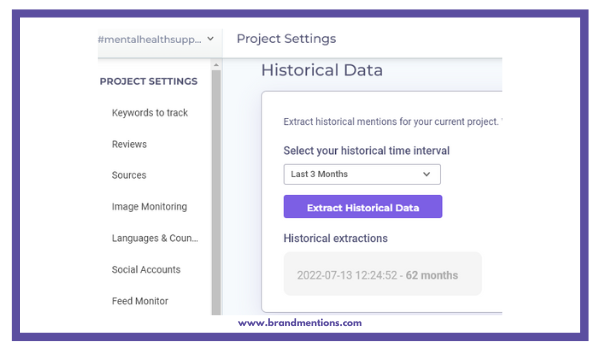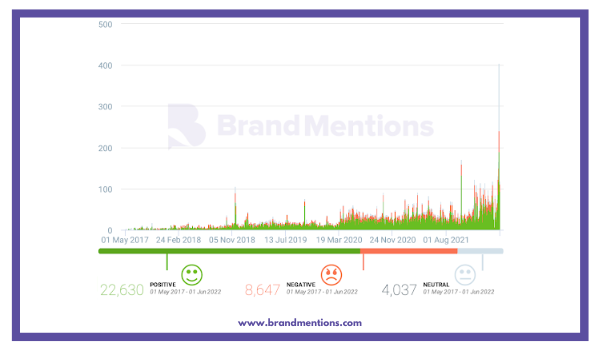Academic research uses formal, scientific and systematic procedures to discover answers. Putting it simple, this type of research means that you don’t know, but are willing to find out. This was the case of University of Social Sciences and Humanities Warsaw who used BrandMentions & social listening in their research of mental health issues.
This is a case study provided by a group of researches from the University of Social Sciences and Humanities Warsaw, written and documented by themselves.
Background
I am part of a group of psychology students at the University of Social Sciences and Humanities Warsaw.
Under the supervision of our professor, we were tasked with designing and creating a study on the topic of social beliefs. Our study goal and hypothesis were to see whether the Covid-19 pandemic had changed the way people act, feel, think and believe about and towards people struggling with mental health problems.
When we brought her the idea for this study, she worried that we were biting over too much and that we wouldn't be able to get everything done in time.
Archival Big Data and social media research is a big and complex form of social psychological research that often takes a long time to complete and often holds results that are difficult to interpret.
Doing some online searches for a way to complete this research and analysis simply, I came across the BrandMentions tool that works based on various technical algorithms and artificial intelligence. Chan et al., (2017) lists monitoring vendors of social media data as a great way to analyze data.
Although none of the other vendors I spoke to were able to help us with the specific thing we needed to measure.
How BrandMentions Helped The Study
BrandMentions tool was also the only tool I found able to extract historical data as far back as needed for this study (5 years), with a maximum of being able to go back 10 years.
The BrandMentions tool also provides automatically produced graphs and tables that visually organize the data, as well as the ability to extract the data into a form that can be opened by programs such as Excel or Google Sheets.

This allowed us to analyze the analyzed data using other tools such as correlation analysis tools.
It was concluded that this method of study was the most appropriate in order to collect
data that could shed light on our hypothesis.
The BrandMentions tool allowed us to see trends forming over time clearly, and it allowed us to accurately see backward in time by using the "extract historical data" function.

Using this method, we were also able to avoid being in direct contact with the study participants, eliminating participant bias.
It also allowed us to collect data from people acting in completely natural ways in a naturalistic setting and to collect very large samples of data.
BrandMentions allowed us to store and analyze up to 150,000 mentions at any one time. After this limit was reached, we were able to export the reports of the analyses, delete the projects from the server, and start over.

To search for the terms using the tool, we could simply put in the terms we wanted to
search for. The tool allowed boolean operators to be used in the search terms such as AND,
NOT, OR, etc. This means we could make the tool find only mentions that include some
words, exclude others, and more complex combinations of this.
We generated projects on different search terms and hashtags related to our
hypothesis, such as #mentalhealthsupport on Twitter.

Figure 1.
Mentions of #mentalhealthsupport on Twitter (#MHST)
Note. Chart automatically produced by BrandMentions showing the amount of mentions of the #mentalhealthsupport hashtag on Twitter; each bar represents a day, and the data collected. It starts May 1, 2017, and ends June 1, 2022.
The height of each bar represents how many times the hashtag was used in any tweet. February 27th is marked on the chart for reference.
Results
As can be seen in Figure 1. The graph shows a clear increase in mentions right after Covid-19 started. Along with other results of the study and after running a t-test to determine the reliability of the results, our professor was shocked with what we were able to accomplish using this tool.
Another interesting tip about this tool in use for research, you can instantly generate a report on the participants and what country the mentions come from.
 Figure 2.
Figure 2.
Distribution of mentions by country (#mentalhealthsupport Twitter (#MHST))
Note: This model shows the distribution and concentration of the number of mentions by
country for #MHST.

Figure 3.
Sentiment analysis of #mentalhealthsupport on Twitter (#MHST)
Note. This graph shows the positive and negative sentiment of tweets containing
#mentalhealthsupport over time. The green parts of the bars represent positive sentiment, red represents negative sentiment, and gray represents neutral. The height of the bar still represents the total number of mentions.
Using BrandMention’s sentiment analysis tool, we were able to see in what ways
people were talking in the tweets that included our searched mentions.
As can be seen in Figure 3. the general sentiment related to the search term seems to stay relatively the same over time, although this may not be relevant as it can be explained by the mechanism of the sentiment analysis itself.
The sentiment analysis works using artificial intelligence to differentiate between tweets that use positive or negative language (BrandMentions, n.d.). Although after looking through which mentions were flagged as negative and positive, I understood that mentions where for example, someone talked about being depressed as a result of covid would be flagged as negative, even though the overall sentiment towards the topic of mental health awareness may be positive.
This highlights the complexity of sentiment analysis, especially in nuanced discussions like mental health. While AI can categorize language, it may not fully grasp the context in which certain emotions are expressed. This is why businesses, including those offering writing service, often rely on human oversight alongside AI tools to ensure a more accurate interpretation of sentiment and intent.
The Experience of Working with BrandMentions
Working with this tool has made my social sociological research fast, easy and fun. I was
excited when I got a new idea of which variables to put into the tool to see how it could help me learn.
Every member of our group would recommend BrandMentions to anyone doing social psychological research that would benefit from large sample sizes, naturalistic data
sets, and the ability to go 10 years back in time with the click of a button and automatically
generated graphs, tables, and reports for most different kinds of useful data.
BrandMentions also give you a list of the mentions in the “mentions” tab, which allows you to go through the mentions individually in order to see deeper into your data and understand what people are talking about.
BrandMentions (n.d.) BrandMentions. Retrieved May 26, 2022 - June 2, 2022, from https://help.brandmentions.com/en/articles/3582915-how-does-the-sentiment-analysis-work
Chan, M.-P. S., Morales, A., Farhadloo, M., Palmer, R., & Albarracin, D. (2017). Harvesting and Harnessing Social Media Data for Psychological Research.
Ambjørn Dahle - Student at the University of Social Sciences and Humanities Warsaw.




